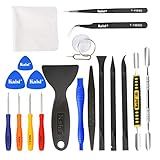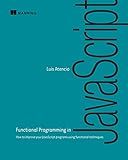Best JavaScript Error Handling Tools to Buy in December 2025

GraphQL Best Practices: Gain hands-on experience with schema design, security, and error handling



Kaisi Professional Electronics Opening Pry Tool Repair Kit with Metal Spudger Non-Abrasive Nylon Spudgers and Anti-Static Tweezers for Cellphone iPhone Laptops Tablets and More, 20 Piece
- COMPLETE 20-PC KIT FOR EFFORTLESS ELECTRONIC DISASSEMBLY AND REPAIR.
- DURABLE STAINLESS STEEL TOOLS ENSURE LONGEVITY AND REPEATED USE.
- INCLUDES ESSENTIAL CLEANING TOOLS FOR A FLAWLESS FINISH POST-REPAIR.



Full Stack JavaScript Strategies: The Hidden Parts Every Mid-Level Developer Needs to Know



Software Design by Example



Decoding JavaScript: A Simple Guide for the Not-so-Simple JavaScript Concepts, Libraries, Tools, and Frameworks (English Edition)



Functional Programming in JavaScript: How to improve your JavaScript programs using functional techniques



200+ JavaScript Programs for Beginners (Javascript MEGA bundle Book 1)



50 JavaScript Concepts Every Developer Should Know: The Perfect Guide Every JavaScript Developer Needs to Get Started (Javascript MEGA bundle Book 6)


To catch a dynamic import error in JavaScript, you can use a try-catch block.
- Wrap the dynamic import statement inside a try block. For example:
try { const module = await import('./module.js'); // code to execute if the import is successful } catch (error) { // code to handle the error }
- Within the catch block, you can handle the error that occurred during the import process. This can include logging the error, displaying a user-friendly message, or performing any other necessary actions. For example:
try { const module = await import('./module.js'); // code to execute if the import is successful } catch (error) { console.error('Error occurred during import:', error); // Handle the error as per your requirement }
- The catch block will be executed if any error occurs during the dynamic import. This can include issues like the file not being found, network errors, or any other import-related error.
By using a try-catch block around the dynamic import, you can gracefully handle any errors that might occur during the import process and provide appropriate feedback or take necessary actions based on the error encountered.
How can you debug dynamic import errors in JavaScript?
To debug dynamic import errors in JavaScript, you can follow these steps:
- Check for syntax errors: Ensure that the dynamic import statement is correctly written and placed in your code. Any missing or incorrect syntax can cause errors.
- Use a try...catch block: Surround your dynamic import statement with a try...catch block. This allows you to catch any errors that occur during the import and handle them appropriately.
try { const module = await import('./path/to/module'); // Do something with the imported module } catch (error) { console.error(error); }
- Enable source maps: If you're using tools like webpack or Babel, enable source maps. Source maps allow you to see the original source code (instead of the compiled/transpiled code) in your browser's developer tools, making it easier to debug.
- Check network requests: When using dynamic import, JavaScript fetches the module asynchronously via the network. Use your browser's developer tools to check the network tab and ensure that the requested module is being loaded correctly. Look for any HTTP errors that may indicate issues with fetching the module.
- Validate module paths: Make sure that the path to the module you are importing is correct. Double-check that you have specified the correct path, including the correct file extension and any necessary relative directory references.
- Check for module export: Verify that the module you are importing has the correct export. For example, if you are importing a default export, ensure that the module you are importing actually has a default export to avoid "undefined" errors.
- Utilize console logging: Use console.log statements to output helpful messages at various stages of the dynamic import process. You can add console.log before and after the dynamic import statement to check if it gets executed, and also within the module to verify if the module is correctly loaded.
By following these steps and examining the error messages or console logs, you can identify and resolve issues with dynamic imports in JavaScript.
Can you catch a dynamic import error only if it matches a specific condition?
Yes, it is possible to catch a dynamic import error only if it matches a specific condition. Here's an example code snippet in JavaScript:
try { const module = await import('./path/to/module');
if (/* Add your specific condition here */) { // Handle the successful import } else { throw new Error('Import does not match the specific condition'); } } catch (error) { // Catch and handle the error console.error('Dynamic import error:', error); }
In this example, the await import('./path/to/module') line dynamically imports a module. After the import, you can add your specific condition using an if statement to check whether the imported module meets the desired condition. If the condition is not satisfied, you can throw an error to be caught in the catch block. This way, only errors that match the specific condition will be caught and handled in the catch block, while other import errors will propagate further up the call stack.
What are the best practices for catching dynamic import errors in JavaScript?
When working with dynamic imports in JavaScript, it is crucial to handle any potential errors that may occur. Here are some best practices for catching dynamic import errors:
- Use try/catch block: Wrap your dynamic import code in a try/catch block. This allows you to catch any errors that occur during the import process.
try { const module = await import('./path/to/module.js'); // Use the imported module here } catch (error) { // Handle the error here }
- Check for SyntaxErrors: In some cases, there might be syntax errors in the imported module. You can catch these errors specifically using the try/catch block.
try { const module = await import('./path/to/module.js'); // Use the imported module here } catch (error) { if (error instanceof SyntaxError) { // Handle the syntax error here } else { // Handle other errors } }
- Handle the Promise rejection: If you are using promises for dynamic imports, you can handle the rejection of the promise using the .catch() method.
import('./path/to/module.js') .then(module => { // Use the imported module here }) .catch(error => { // Handle the error here });
- Provide fallbacks: In case the dynamic import fails, you can provide fallback mechanisms or alternative actions. This can include loading a default behavior, showing an error message, or redirecting the user to a different page.
import('./path/to/module.js') .then(module => { // Use the imported module here }) .catch(error => { // Handle the error here console.error('Failed to load module:', error); // Fallback or alternative actions can be implemented here });
By following these best practices, you can effectively catch and handle dynamic import errors, leading to more robust and error-resilient code.
Can you provide an example of using a tool or library to catch dynamic import errors?
Certainly! One of the popular tools used for catching dynamic import errors in JavaScript is the webpack bundler. With webpack, you can utilize the import() function to dynamically import modules and handle any potential errors.
Here's an example configuration using webpack to catch dynamic import errors:
- Install webpack and the necessary loaders:
npm install webpack webpack-cli babel-loader @babel/preset-env
- Create a webpack.config.js file in your project's root directory with the following content:
module.exports = { entry: './src/index.js', output: { filename: 'bundle.js', path: __dirname + '/dist', }, module: { rules: [ { test: /\.js$/, exclude: /node_modules/, use: { loader: 'babel-loader', options: { presets: ['@babel/preset-env'], }, }, }, ], }, };
- Create an index.js file in the src folder with the following content:
const loadModule = async () => { try { const module = await import('./module'); module.default(); } catch (error) { console.error('Dynamic import error:', error); } };
loadModule();
- Create a module.js file in the src folder with the following content:
export default function hello() { console.log('Hello, dynamic import!'); }
- Run webpack to build the project:
npx webpack
- Now, if there is an error during the dynamic import, it will be caught and logged in the browser console.
In the provided example, if there is an error while importing the module.js file, such as a network failure or an incorrect file path, the error will be caught by the catch block and logged to the console.
What is the advantage of using try-catch blocks over other error handling methods?
One of the advantages of using try-catch blocks over other error handling methods is that they provide a structured and more readable way to handle exceptions in code.
- Error containment: By enclosing a specific section of code within a try block, any exceptions raised within that block are caught and handled within the catch block. This prevents the exception from propagating up the call stack and potentially crashing the program.
- Flexibility: Unlike other error handling methods like return codes or if-else conditions, try-catch blocks allow you to handle exceptions in a centralized way, regardless of where the exception is thrown. This flexibility enables more modular and maintainable code.
- Readability: Try-catch blocks make the code more readable by separating the normal code flow from the exceptional flow. This makes it easier to understand and reason about the code.
- Multiple exception handling: Try-catch blocks allow you to catch and handle different types of exceptions separately. This enables you to take different actions based on the type of exception raised, improving error-specific handling.
- Clean-up operations: Finally, try-catch blocks can also include a finally block, which executes regardless of whether an exception is thrown or caught. This allows you to perform any necessary clean-up operations, such as closing files or releasing resources, ensuring the program runs in a consistent state.
Overall, try-catch blocks provide a more organized and elegant way of handling exceptions and ensure better control flow in the presence of errors.
